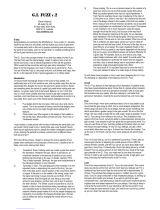
English Owner's Manual ODR-CS
Introduction
Thank you for purchasing this effect device! Like my other products, I value good components and build the
devices mainly by hand and measure the devices personally several times. Because only when it meets my
own quality requirements does the device go into delivery.
On my website you can read the development of the ODR-S at that time in more detail.
You can also find a more detailed description of the development of the Nordland ODR-CS on my website!
This is the detailed guide with some technical background to explain the functions better.
Development
The ODR-CS (Overdrive Custom Special) is the successor to my development (ODR-S) from 1993. It has two
consecutive distortion stages. The first is a classic overdrive circuit with two silicon diodes in the feedback
path of an operational amplifier (also called soft clipping). At the end of this stage, two germanium diodes
were added as limiters. (So called hard clipping).
Unfortunately, these special germanium diodes have not been manufactured for decades. In my opinion, a
new edition was no longer possible in series. But then, after a long search and a bit of luck, I had the chance to
acquire a few thousand good sounding germanium diodes as NOS◊
NOS: New Old Stock – i.e. new goods that have been stored for a very long time!
Based on today's experience, I was able to significantly improve the quality of the old ODR-S. I then revised
the sound control, since the old control could still be refined today - 30 years later.
Unfortunately, germanium semiconductors have always had a very high degree of scatter in the
manufacturing process. This meant that each device always sounded slightly different. In order to keep the
scatter small, I measure the germanium diodes with a characteristic curve recorder and select them based on
their forward voltage. Finally, I adjust the effect of the germanium diodes with an internal bias control!
Improvements
9 V to 18 V: The built-in components can handle 18 volts without any problems. The sound of the
ODR-CS changes at an operating voltage between 9 V and 18 V. Please try it yourself!!
Protection against polarity reversal: The device blocks in the event of polarity reversal and thus
protects the electronics.
True Bypass Footswitch: No loss of sound in bypass (effect off).
Soft footswitch click - more comfortable than the usual hard toggles.
Use of high-quality materials, such as: Stable Hammond MFG (England) 1590N1 aluminum housing,
gold-plated Cliff jack sockets (also English company), gold-plated board connectors, boards with ENIG
gold-plated pads, 1% (tolerance) metal film resistors and max. 5% film capacitors in the audio signal
path for best sound quality.
Soft-LED: Gentle on/off thread of the LED brightness to optimally suppress switching clicks.
An LED brightness knob-potentiometer is located inside the ODR-CS!
Selected germanium diodes with an internal bias knob for sound adjustment.
A little G.D.C. knob that can reduce the effect of the germanium diodes (hard clipping).
Optimized tone control for bass and treble.
Extended sound control for the mid knob: not only adds mids, but can now also remove them.










